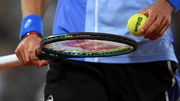
Imago
Coco Gauff *** Coco Gauff Copyright: xJuergenxHasenkopfx

Imago
Coco Gauff *** Coco Gauff Copyright: xJuergenxHasenkopfx
Remember when Rennae Stubbs said, “It is going to be a work in progress with the serve and her forehand for the rest of her career. And when she loses that is why she is going to lose, that’s why we always talk about it”? That stark truth still lingers. Back at Indian Wells, Coco Gauff’s game crumbled under pressure, 21 double faults, 74 unforced errors against Moyuka Uchijima, and six more double faults in her final game against Maria Sakkari before bowing out after losing to Belinda Bencic. Now, even after kicking off her North American swing with a gritty win over Danielle Collins, her Canadian Open run arrives with a brutal reminder: her serve remains her most daunting enemy.
Watch What’s Trending Now!
Top seed Coco Gauff was pushed to the absolute brink by fellow American Danielle Collins on Tuesday night at the Omnium Banque Nationale, but the reigning French Open champ dug deep and clawed her way to a dramatic victory. After nearly three hours of intense baseline warfare, Gauff finally broke her post-Roland Garros dry spell, sealing a 7-5, 4-6, 7-6(2) win in a high-octane clash.
Collins erased deficits of 2-0 and 4-2 in the third set and came within two points of snatching the match. But Coco held her nerve when it mattered most. Still, one stat from the battle screamed louder than the rest: Gauff’s double faults once again hit troubling highs.
ADVERTISEMENT
Just moments ago, Tennis TV’s Bastien Fachan dropped a jaw-dropping stat on Coco Gauff’s performance in Montreal. “Coco Gauff’s 23 double faults tonight in Montreal are the most at WTA level since Anastasia Pavlyuchenkova in Baku 2011,” he shared, underlining the brutal weight of that number. Quickly correcting himself, he added, “(Sabalenka also had 23, my bad, she wasn’t on the record list).” Gauff may have survived the storm, but this stat serves as a stark reminder of the beast she’s still battling.
Coco Gauff’s 23 double faults tonight in Montreal are the most at WTA level since Anastasia Pavlyuchenkova in Baku 2011
— Bastien Fachan (@BastienFachan) July 30, 2025
Even after surviving a grueling 2-hour and 55-minute war, Coco Gauff faced the truth head-on. “I was practicing well and I don’t think I transferred it today, but hopefully I got my bad match of the tournament out of the way,” she admitted, reflecting on a night filled with 23 double faults and 74 unforced errors.
ADVERTISEMENT
Gauff kept her humor intact, saying, “Maybe if I cut that in half, it would be a quicker match for me,” while assuring fans she still had plenty “left in the tank.” Despite the chaos, she held onto the silver linings: “Danielle is a great ball striker, and for me to break her as many times as I did, there’s definitely some positives to take from today.”
This isn’t the first time Coco Gauff has battled haunting numbers on her serve. At this year’s Wimbledon, her campaign ended in the opening round, where the World No. 2 unravelled on Court No. 1, managing just six winners and racking up 29 unforced errors, and nine double faults. The serve, once again, proved costly.
ADVERTISEMENT
In Berlin, too, returning to the tour after her French Open triumph, Gauff was stunned by Chinese qualifier Wang Xinyu. She piled up 25 unforced errors and seven double faults in a 6-3, 6-3 loss that echoed all too familiar concerns. And who could forget her clash at the Italian Open? There, Jasmine Paolini dismantled her game as Gauff delivered eight double faults and 55 unforced errors in a brutal 6-4, 6-2 defeat.
Now, as Gauff marches into the R32 in Montreal, the message is loud and clear. She must take to heart the advice she’s received about taming those double faults; it might just define her future.
ADVERTISEMENT
Pam Shriver urges Coco Gauff to sharpen her strokes
Despite her shining triumph in Paris, Coco Gauff’s game still flashes signs of instability, most glaringly in her inconsistency and error count. One red flag that refuses to fade is her growing struggle with double faults. Hard to digest, but Gauff committed 38 double faults during her victorious Roland Garros campaign alone. Heading into her opening match in the Montreal Open, Gauff had 250 double faults to her name. Last year, she topped the same list with 430, marking a troubling pattern.
But Gauff’s challenges extend beyond the serve. Former American legend Pam Shriver pointed out another critical area for improvement last month: her forehand. While Gauff’s speed and competitiveness make her a menace on court, her forehand has often lacked bite and reliability, especially under pressure.
Top Stories
Match-Fixing Scandal Erupts in Tennis After Arrests Uncover $821K Scheme

Carlos Alcaraz’s Split With Coach Resulted From ‘Major Disagreements’ With His Father

Carlos Alcaraz Split With Juan Carlos Ferrero After “Unacceptable” Contract Talks Turn Sour

Naomi Osaka Ends Chapter With Longtime Business Partner in Major Off-Court Move

Top 3 Biggest Match Fixing Scandals in Tennis History

In a candid conversation with Arab News on June 30, Shriver, a three-time Wimbledon semifinalist, offered a sharp observation: “Obviously, given her competitiveness, her speed, if the forehand, actually I’m anxious to see, I want to see how much she slices it, because I think that’s a shot she’s had to utilize, given when the regular forehand’s not working, she can kind of bunt it around, and kind of just chip it back, use her speed, and then wait for a backhand.”
ADVERTISEMENT
She didn’t stop there. “So we’ll see how much she does that, and also her drive’s tough,” Shriver added, touching on the difficulty Gauff faces in consistently generating offensive forehands. It’s an issue that’s shadowed the 21-year-old for a while now.
Even Gauff acknowledged the gap herself. After her early exit in Miami against Anastasia Potapova, she confessed, “I think I need to work on the execution part because I am executing them in practice, certain moments in practice,” as reported by TNT Sports back in March.
Now, with her next challenge against Veronika Kudermetova on the horizon and the US Open fast approaching, the stakes couldn’t be higher. Can Coco silence the doubts, sharpen her tools, and unleash her best when it matters most? Time will tell!
ADVERTISEMENT
ADVERTISEMENT
ADVERTISEMENT
ADVERTISEMENT

